Comprehensive Report: Managing People and Organization Analysis
VerifiedAdded on 2020/05/16
|6
|1324
|207
Report
AI Summary
This report examines the principles of managing people and organizations, focusing on the application of the POLC framework (Planning, Organizing, Leading, and Controlling) in a multinational company setting. Part A details a real-world scenario where a manager successfully addressed team conflict and fostered collaboration by implementing strategic planning, organizational restructuring, leadership initiatives, and performance control measures. Part B delves into organizational behavior, highlighting the significance of adapting to a diverse workforce and applying theories like Cognitive Dissonance and Self-Perception to understand employee attitudes and behaviors within the Australian Football League. The report emphasizes the importance of understanding these theories to reduce internal and external factors that affect the organization and enhance overall performance. The document highlights the application of various other theories such as Attribution Theory, Goal Setting Theory, Reinforcement Theory, Equity Theory, Expectancy Theory, and many more can be applied in the organizational setting. Furthermore, it underscores the necessity for managers to balance employee work and personal lives for optimal results.
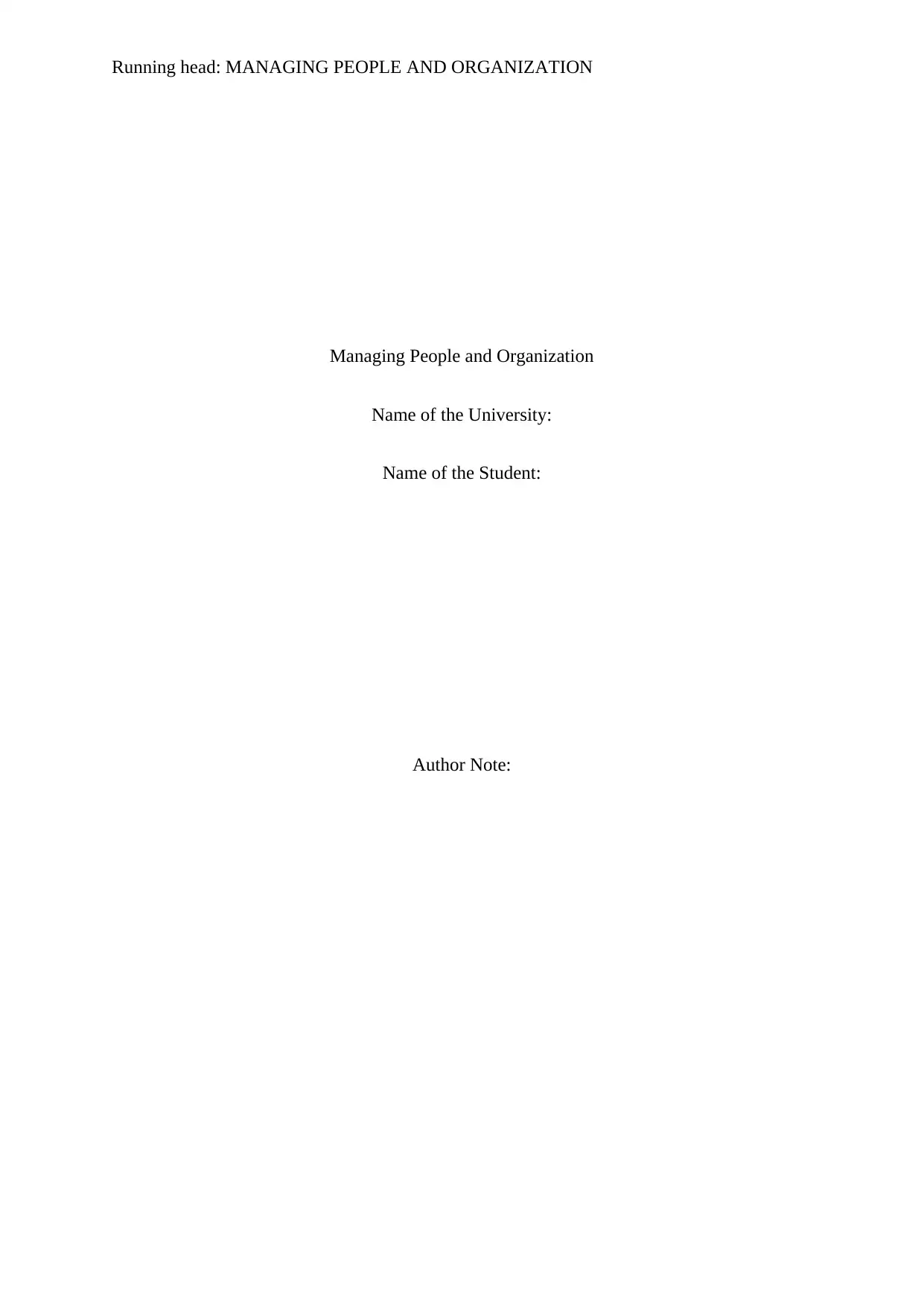
Running head: MANAGING PEOPLE AND ORGANIZATION
Managing People and Organization
Name of the University:
Name of the Student:
Author Note:
Managing People and Organization
Name of the University:
Name of the Student:
Author Note:
Paraphrase This Document
Need a fresh take? Get an instant paraphrase of this document with our AI Paraphraser
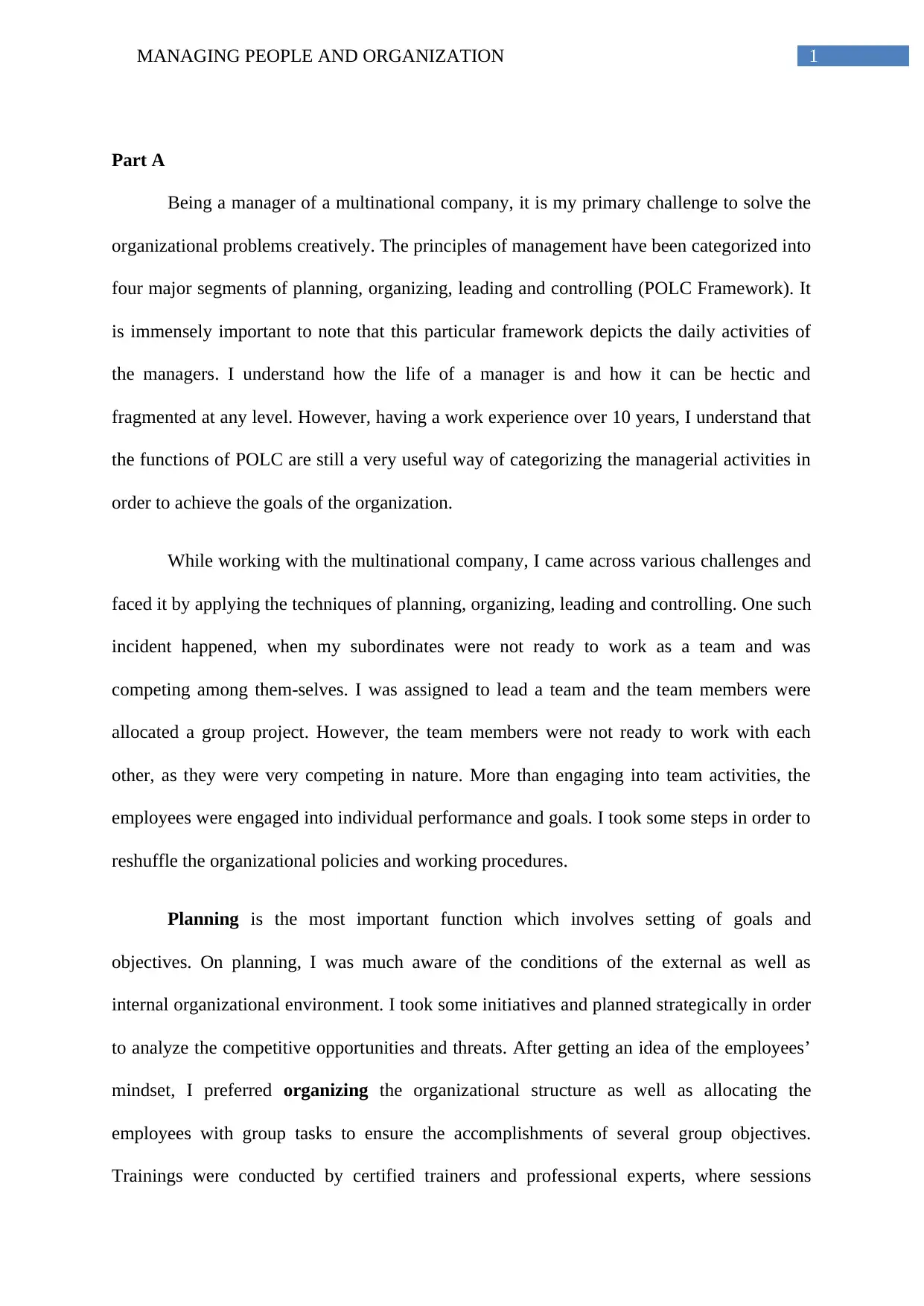
1MANAGING PEOPLE AND ORGANIZATION
Part A
Being a manager of a multinational company, it is my primary challenge to solve the
organizational problems creatively. The principles of management have been categorized into
four major segments of planning, organizing, leading and controlling (POLC Framework). It
is immensely important to note that this particular framework depicts the daily activities of
the managers. I understand how the life of a manager is and how it can be hectic and
fragmented at any level. However, having a work experience over 10 years, I understand that
the functions of POLC are still a very useful way of categorizing the managerial activities in
order to achieve the goals of the organization.
While working with the multinational company, I came across various challenges and
faced it by applying the techniques of planning, organizing, leading and controlling. One such
incident happened, when my subordinates were not ready to work as a team and was
competing among them-selves. I was assigned to lead a team and the team members were
allocated a group project. However, the team members were not ready to work with each
other, as they were very competing in nature. More than engaging into team activities, the
employees were engaged into individual performance and goals. I took some steps in order to
reshuffle the organizational policies and working procedures.
Planning is the most important function which involves setting of goals and
objectives. On planning, I was much aware of the conditions of the external as well as
internal organizational environment. I took some initiatives and planned strategically in order
to analyze the competitive opportunities and threats. After getting an idea of the employees’
mindset, I preferred organizing the organizational structure as well as allocating the
employees with group tasks to ensure the accomplishments of several group objectives.
Trainings were conducted by certified trainers and professional experts, where sessions
Part A
Being a manager of a multinational company, it is my primary challenge to solve the
organizational problems creatively. The principles of management have been categorized into
four major segments of planning, organizing, leading and controlling (POLC Framework). It
is immensely important to note that this particular framework depicts the daily activities of
the managers. I understand how the life of a manager is and how it can be hectic and
fragmented at any level. However, having a work experience over 10 years, I understand that
the functions of POLC are still a very useful way of categorizing the managerial activities in
order to achieve the goals of the organization.
While working with the multinational company, I came across various challenges and
faced it by applying the techniques of planning, organizing, leading and controlling. One such
incident happened, when my subordinates were not ready to work as a team and was
competing among them-selves. I was assigned to lead a team and the team members were
allocated a group project. However, the team members were not ready to work with each
other, as they were very competing in nature. More than engaging into team activities, the
employees were engaged into individual performance and goals. I took some steps in order to
reshuffle the organizational policies and working procedures.
Planning is the most important function which involves setting of goals and
objectives. On planning, I was much aware of the conditions of the external as well as
internal organizational environment. I took some initiatives and planned strategically in order
to analyze the competitive opportunities and threats. After getting an idea of the employees’
mindset, I preferred organizing the organizational structure as well as allocating the
employees with group tasks to ensure the accomplishments of several group objectives.
Trainings were conducted by certified trainers and professional experts, where sessions
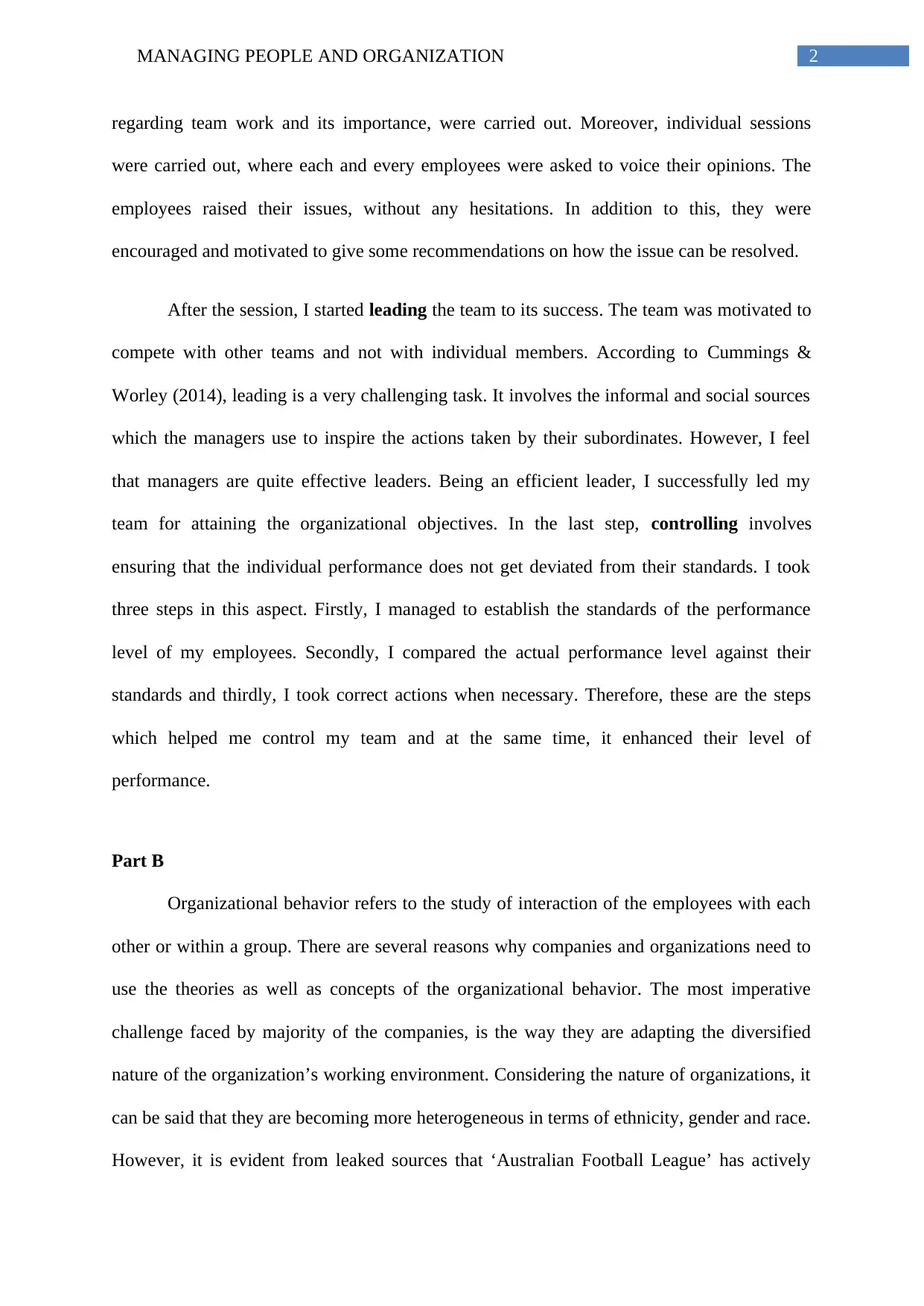
2MANAGING PEOPLE AND ORGANIZATION
regarding team work and its importance, were carried out. Moreover, individual sessions
were carried out, where each and every employees were asked to voice their opinions. The
employees raised their issues, without any hesitations. In addition to this, they were
encouraged and motivated to give some recommendations on how the issue can be resolved.
After the session, I started leading the team to its success. The team was motivated to
compete with other teams and not with individual members. According to Cummings &
Worley (2014), leading is a very challenging task. It involves the informal and social sources
which the managers use to inspire the actions taken by their subordinates. However, I feel
that managers are quite effective leaders. Being an efficient leader, I successfully led my
team for attaining the organizational objectives. In the last step, controlling involves
ensuring that the individual performance does not get deviated from their standards. I took
three steps in this aspect. Firstly, I managed to establish the standards of the performance
level of my employees. Secondly, I compared the actual performance level against their
standards and thirdly, I took correct actions when necessary. Therefore, these are the steps
which helped me control my team and at the same time, it enhanced their level of
performance.
Part B
Organizational behavior refers to the study of interaction of the employees with each
other or within a group. There are several reasons why companies and organizations need to
use the theories as well as concepts of the organizational behavior. The most imperative
challenge faced by majority of the companies, is the way they are adapting the diversified
nature of the organization’s working environment. Considering the nature of organizations, it
can be said that they are becoming more heterogeneous in terms of ethnicity, gender and race.
However, it is evident from leaked sources that ‘Australian Football League’ has actively
regarding team work and its importance, were carried out. Moreover, individual sessions
were carried out, where each and every employees were asked to voice their opinions. The
employees raised their issues, without any hesitations. In addition to this, they were
encouraged and motivated to give some recommendations on how the issue can be resolved.
After the session, I started leading the team to its success. The team was motivated to
compete with other teams and not with individual members. According to Cummings &
Worley (2014), leading is a very challenging task. It involves the informal and social sources
which the managers use to inspire the actions taken by their subordinates. However, I feel
that managers are quite effective leaders. Being an efficient leader, I successfully led my
team for attaining the organizational objectives. In the last step, controlling involves
ensuring that the individual performance does not get deviated from their standards. I took
three steps in this aspect. Firstly, I managed to establish the standards of the performance
level of my employees. Secondly, I compared the actual performance level against their
standards and thirdly, I took correct actions when necessary. Therefore, these are the steps
which helped me control my team and at the same time, it enhanced their level of
performance.
Part B
Organizational behavior refers to the study of interaction of the employees with each
other or within a group. There are several reasons why companies and organizations need to
use the theories as well as concepts of the organizational behavior. The most imperative
challenge faced by majority of the companies, is the way they are adapting the diversified
nature of the organization’s working environment. Considering the nature of organizations, it
can be said that they are becoming more heterogeneous in terms of ethnicity, gender and race.
However, it is evident from leaked sources that ‘Australian Football League’ has actively
⊘ This is a preview!⊘
Do you want full access?
Subscribe today to unlock all pages.

Trusted by 1+ million students worldwide
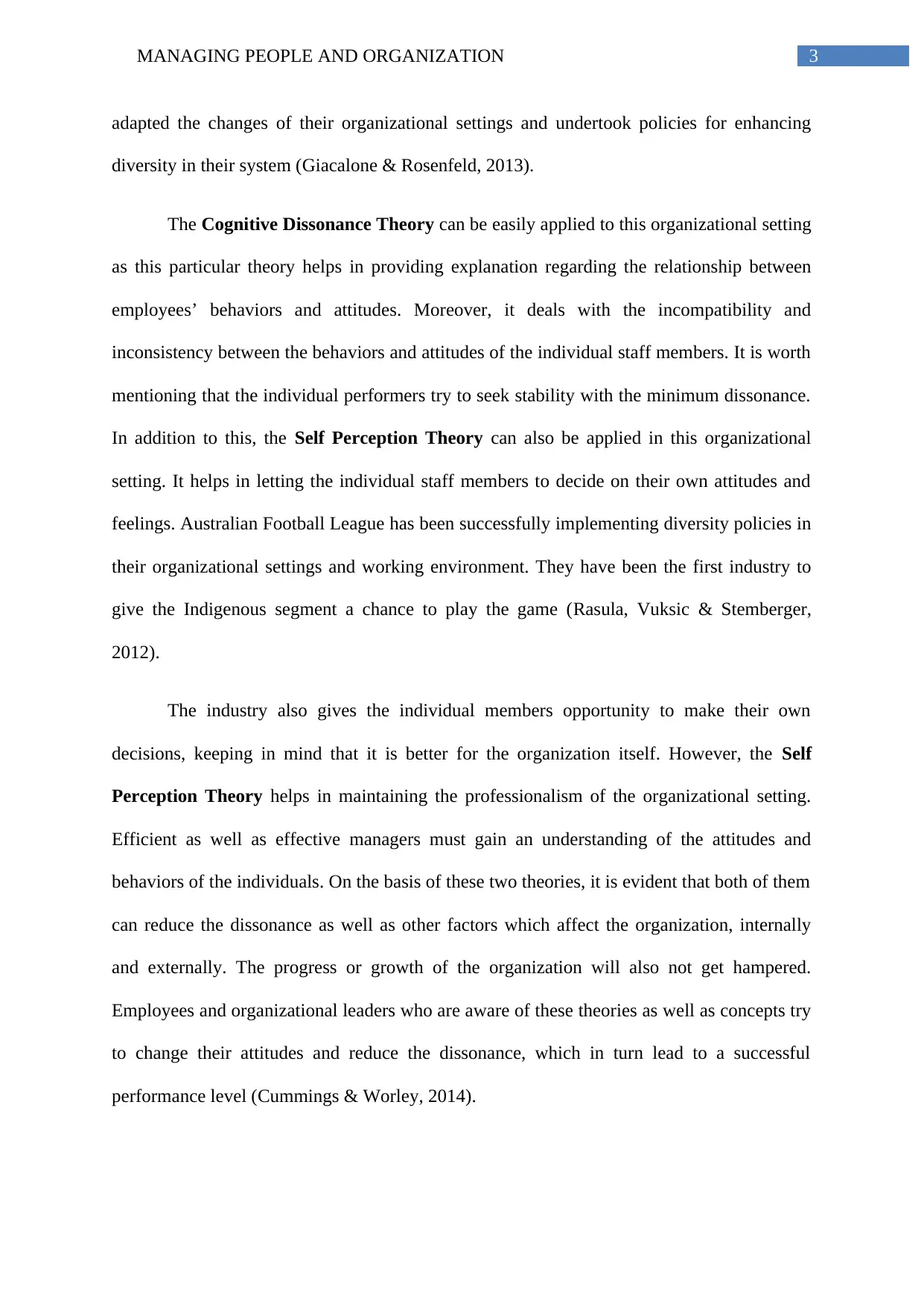
3MANAGING PEOPLE AND ORGANIZATION
adapted the changes of their organizational settings and undertook policies for enhancing
diversity in their system (Giacalone & Rosenfeld, 2013).
The Cognitive Dissonance Theory can be easily applied to this organizational setting
as this particular theory helps in providing explanation regarding the relationship between
employees’ behaviors and attitudes. Moreover, it deals with the incompatibility and
inconsistency between the behaviors and attitudes of the individual staff members. It is worth
mentioning that the individual performers try to seek stability with the minimum dissonance.
In addition to this, the Self Perception Theory can also be applied in this organizational
setting. It helps in letting the individual staff members to decide on their own attitudes and
feelings. Australian Football League has been successfully implementing diversity policies in
their organizational settings and working environment. They have been the first industry to
give the Indigenous segment a chance to play the game (Rasula, Vuksic & Stemberger,
2012).
The industry also gives the individual members opportunity to make their own
decisions, keeping in mind that it is better for the organization itself. However, the Self
Perception Theory helps in maintaining the professionalism of the organizational setting.
Efficient as well as effective managers must gain an understanding of the attitudes and
behaviors of the individuals. On the basis of these two theories, it is evident that both of them
can reduce the dissonance as well as other factors which affect the organization, internally
and externally. The progress or growth of the organization will also not get hampered.
Employees and organizational leaders who are aware of these theories as well as concepts try
to change their attitudes and reduce the dissonance, which in turn lead to a successful
performance level (Cummings & Worley, 2014).
adapted the changes of their organizational settings and undertook policies for enhancing
diversity in their system (Giacalone & Rosenfeld, 2013).
The Cognitive Dissonance Theory can be easily applied to this organizational setting
as this particular theory helps in providing explanation regarding the relationship between
employees’ behaviors and attitudes. Moreover, it deals with the incompatibility and
inconsistency between the behaviors and attitudes of the individual staff members. It is worth
mentioning that the individual performers try to seek stability with the minimum dissonance.
In addition to this, the Self Perception Theory can also be applied in this organizational
setting. It helps in letting the individual staff members to decide on their own attitudes and
feelings. Australian Football League has been successfully implementing diversity policies in
their organizational settings and working environment. They have been the first industry to
give the Indigenous segment a chance to play the game (Rasula, Vuksic & Stemberger,
2012).
The industry also gives the individual members opportunity to make their own
decisions, keeping in mind that it is better for the organization itself. However, the Self
Perception Theory helps in maintaining the professionalism of the organizational setting.
Efficient as well as effective managers must gain an understanding of the attitudes and
behaviors of the individuals. On the basis of these two theories, it is evident that both of them
can reduce the dissonance as well as other factors which affect the organization, internally
and externally. The progress or growth of the organization will also not get hampered.
Employees and organizational leaders who are aware of these theories as well as concepts try
to change their attitudes and reduce the dissonance, which in turn lead to a successful
performance level (Cummings & Worley, 2014).
Paraphrase This Document
Need a fresh take? Get an instant paraphrase of this document with our AI Paraphraser
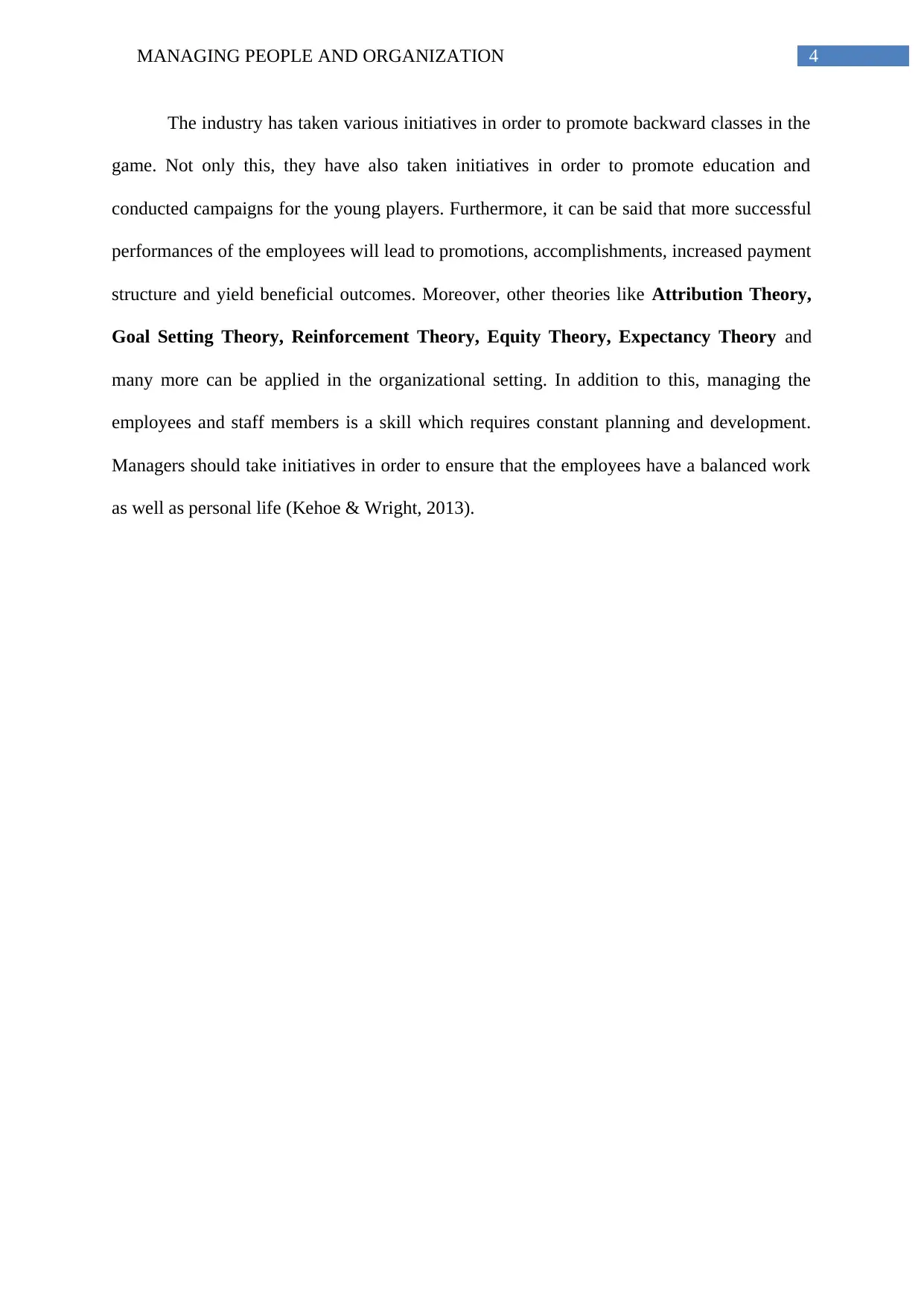
4MANAGING PEOPLE AND ORGANIZATION
The industry has taken various initiatives in order to promote backward classes in the
game. Not only this, they have also taken initiatives in order to promote education and
conducted campaigns for the young players. Furthermore, it can be said that more successful
performances of the employees will lead to promotions, accomplishments, increased payment
structure and yield beneficial outcomes. Moreover, other theories like Attribution Theory,
Goal Setting Theory, Reinforcement Theory, Equity Theory, Expectancy Theory and
many more can be applied in the organizational setting. In addition to this, managing the
employees and staff members is a skill which requires constant planning and development.
Managers should take initiatives in order to ensure that the employees have a balanced work
as well as personal life (Kehoe & Wright, 2013).
The industry has taken various initiatives in order to promote backward classes in the
game. Not only this, they have also taken initiatives in order to promote education and
conducted campaigns for the young players. Furthermore, it can be said that more successful
performances of the employees will lead to promotions, accomplishments, increased payment
structure and yield beneficial outcomes. Moreover, other theories like Attribution Theory,
Goal Setting Theory, Reinforcement Theory, Equity Theory, Expectancy Theory and
many more can be applied in the organizational setting. In addition to this, managing the
employees and staff members is a skill which requires constant planning and development.
Managers should take initiatives in order to ensure that the employees have a balanced work
as well as personal life (Kehoe & Wright, 2013).
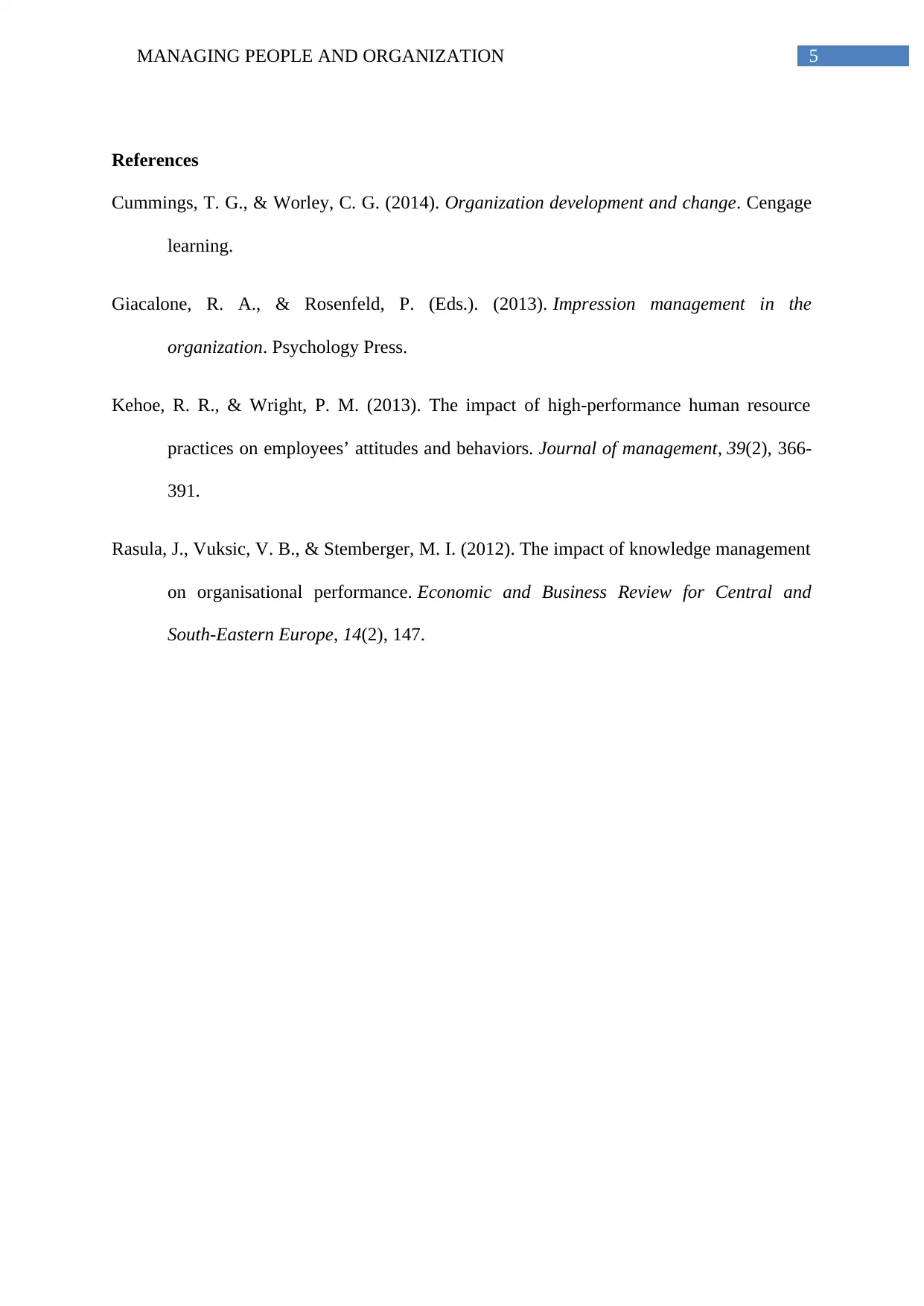
5MANAGING PEOPLE AND ORGANIZATION
References
Cummings, T. G., & Worley, C. G. (2014). Organization development and change. Cengage
learning.
Giacalone, R. A., & Rosenfeld, P. (Eds.). (2013). Impression management in the
organization. Psychology Press.
Kehoe, R. R., & Wright, P. M. (2013). The impact of high-performance human resource
practices on employees’ attitudes and behaviors. Journal of management, 39(2), 366-
391.
Rasula, J., Vuksic, V. B., & Stemberger, M. I. (2012). The impact of knowledge management
on organisational performance. Economic and Business Review for Central and
South-Eastern Europe, 14(2), 147.
References
Cummings, T. G., & Worley, C. G. (2014). Organization development and change. Cengage
learning.
Giacalone, R. A., & Rosenfeld, P. (Eds.). (2013). Impression management in the
organization. Psychology Press.
Kehoe, R. R., & Wright, P. M. (2013). The impact of high-performance human resource
practices on employees’ attitudes and behaviors. Journal of management, 39(2), 366-
391.
Rasula, J., Vuksic, V. B., & Stemberger, M. I. (2012). The impact of knowledge management
on organisational performance. Economic and Business Review for Central and
South-Eastern Europe, 14(2), 147.
⊘ This is a preview!⊘
Do you want full access?
Subscribe today to unlock all pages.

Trusted by 1+ million students worldwide
1 out of 6
Related Documents
Your All-in-One AI-Powered Toolkit for Academic Success.
+13062052269
info@desklib.com
Available 24*7 on WhatsApp / Email
![[object Object]](/_next/static/media/star-bottom.7253800d.svg)
Unlock your academic potential
Copyright © 2020–2025 A2Z Services. All Rights Reserved. Developed and managed by ZUCOL.



